The Nikon FM manual provides a comprehensive guide to understanding and using the Nikon FM camera. It covers features, operation, and troubleshooting.
Overview of the Nikon FM Camera
The Nikon FM is a manual-exposure 35mm single-lens reflex camera introduced in 1982. It features a fully mechanical shutter, making it battery-independent except for the light meter. The camera supports manual and aperture-priority modes, offering precise control for photographers. Compatible with Nikkor lenses, the FM is renowned for its durability and intuitive design. Its compact size and robust build make it a favorite among professionals and enthusiasts. The FM also includes a TTL flash system, enhancing versatility in various lighting conditions. Its timeless appeal lies in its simplicity and reliability.
Importance of the Manual for Optimal Usage
The Nikon FM manual is essential for mastering the camera’s operation, ensuring optimal performance. It details functions like manual exposure, aperture-priority mode, and film loading. The guide explains how to use the built-in light meter, adjust shutter speed, and understand ISO settings. Troubleshooting common issues and maintenance tips are also covered. By following the manual, photographers can fully utilize the FM’s features, such as its TTL flash system and compatibility with Nikkor lenses. This ensures precise control and enhances creativity, making the manual indispensable for both professionals and enthusiasts. Proper usage extends the camera’s longevity.
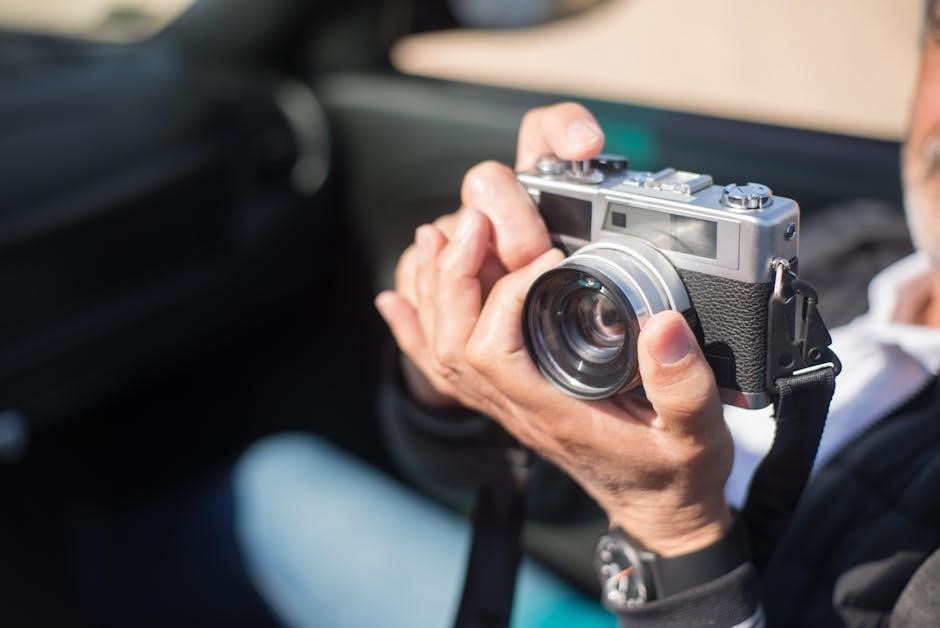
Understanding the Nikon FM Camera Components
The Nikon FM features a shutter speed dial, ISO film speed setting, ADR window, and meter coupling lever. These components work together to enable precise exposure control and optimal functionality. The camera’s design includes a top plate for exposure settings, a lens mount for compatible Nikkor lenses, and a viewfinder with a built-in light meter for accurate metering. Additional components like the film advance lever and frame counter simplify film handling. The manual provides a detailed breakdown of each part, ensuring photographers can maximize the camera’s capabilities for exceptional photography.
Nomenclature and Key Features
The Nikon FM is a 35mm single-lens reflex camera with manual and aperture-priority modes. Its key features include a shutter speed dial, ISO film speed setting, ADR window, and meter coupling lever. The camera is compact, durable, and fully mechanical, offering a reliable shooting experience. It supports Nikkor lenses and features a viewfinder with a built-in light meter for accurate exposures. The FM2 model introduced improvements, such as a top shutter speed of 1/250th of a second and a more reliable battery system. These features make the Nikon FM a versatile tool for photographers seeking precision and control.
Shutter Speed and ISO Film Speed Adjustment
The Nikon FM allows precise control over exposure through its shutter speed and ISO film speed settings. The shutter speed dial, located on the top plate, offers speeds from 1/4 to 1/2000 of a second, plus a Bulb (B) setting for long exposures. ISO film speed is adjusted using a dial on the camera’s rear, with settings from 12 to 6400. Together, these controls enable photographers to achieve optimal exposure by balancing aperture, shutter speed, and film sensitivity. The FM2n model further enhances this with a top shutter speed of 1/4000th of a second for better control in bright conditions.
Meter Coupling Lever and ADR Window
The Meter Coupling Lever on the Nikon FM ensures proper communication between the camera and lens for accurate exposure metering. It links the aperture and shutter speed settings to the built-in light meter. The ADR (Aperture Direct Readout) Window displays the selected aperture value, allowing photographers to quickly verify settings without removing their eye from the viewfinder. Together, these features streamline the exposure process, making it easier to achieve precise control over lighting conditions. This design ensures seamless interaction between the camera and lens for optimal results.
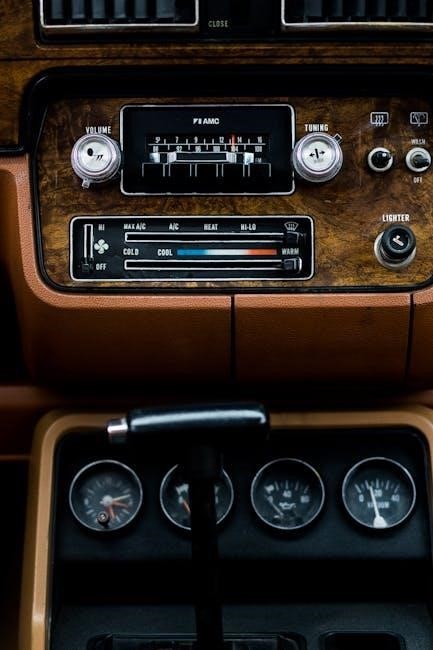
Manual Exposure Modes
The Nikon FM offers Manual Exposure Mode for full control and Aperture-Priority Auto Mode for semi-automatic shooting, providing flexibility and precision in various lighting conditions.
Manual Exposure Mode for Total Control
The Nikon FM’s Manual Exposure Mode offers full control over aperture and shutter speed, allowing photographers to set both parameters independently. This mode is ideal for creative control, enabling precise exposures in various lighting conditions. Suitable for professionals and serious amateurs, it provides the flexibility to adjust settings based on specific artistic or technical needs. The manual includes detailed instructions on using this mode effectively, ensuring optimal results for those who prefer hands-on control over their photography.
Aperture-Priority Auto Exposure Mode
The Nikon FM’s Aperture-Priority Auto Exposure Mode allows photographers to set the aperture while the camera automatically adjusts the shutter speed for optimal exposure. This semi-automatic mode balances creative control with ease of use, making it ideal for various lighting conditions. By selecting the desired aperture, users can influence depth of field while relying on the camera to handle shutter speed adjustments. This mode is particularly useful for photographers who want to prioritize aperture settings without manually adjusting both parameters, ensuring consistent and precise exposures.
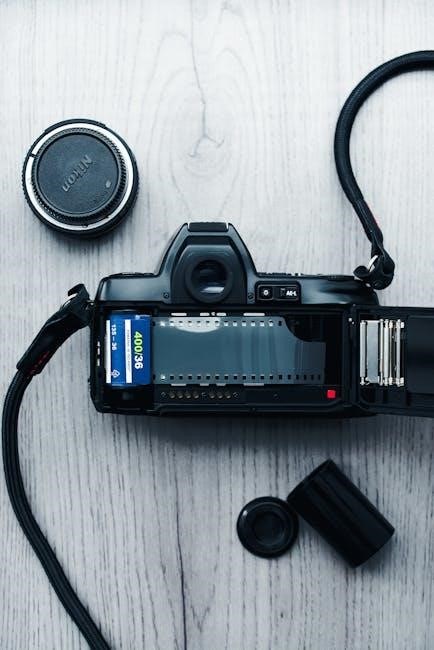
Metering and Exposure Compensation
The Nikon FM features a built-in light meter for accurate exposure readings, allowing precise adjustments. Exposure compensation enables fine-tuning for optimal results in various lighting scenarios.
Using the Built-in Light Meter
The Nikon FM’s built-in light meter provides accurate exposure readings through the ADR window, which measures light intensity. Using the meter coupling lever ensures precise alignment with the shutter speed and aperture settings. This system allows for manual adjustments, enabling photographers to achieve optimal exposure in various lighting conditions. By understanding and utilizing the light meter effectively, users can enhance their control over the camera’s settings, resulting in well-balanced and professional-quality photographs.
Understanding Exposure Compensation
Exposure compensation on the Nikon FM allows photographers to adjust the metered exposure settings to achieve the desired result. This feature is particularly useful in scenarios where the built-in light meter may not accurately capture the intended exposure, such as in backlit or high-contrast situations. By manually overriding the meter’s readings, users can fine-tune the exposure to prevent overexposure or underexposure. The camera’s flash compensation button further enhances control, enabling precise adjustments when using external flash units. This versatility ensures photographers can capture images with optimal lighting and detail, even in challenging conditions.
Focusing with the Nikon FM
The Nikon FM offers precise manual focusing through its high-quality lenses and clear viewfinder. This ensures sharp images and creative depth control.
Manual Focusing Techniques
Manual focusing with the Nikon FM is straightforward and precise. Use the viewfinder’s split-image prism or microprism collar for accurate focus. Turn the lens focus ring gently until your subject is sharp. For moving subjects, pre-focus on a fixed point or use zone focusing by setting a specific depth of field. Ensure the lens is set to manual focus mode by aligning the focus mode switch. Practice these techniques to master sharp images consistently. The FM’s manual focus design emphasizes control and creativity, making it a favorite for photographers who value precision.
Depth of Field Preview
The Nikon FM features a depth of field preview button, enabling photographers to assess the actual depth of field before capturing an image. By pressing this button, the lens aperture closes to the selected f-stop value, allowing you to preview how much of the scene will be in focus. This feature is particularly useful for precise compositions, ensuring sharpness where needed and blur elsewhere. It helps in making informed decisions about aperture settings without relying on guesswork, making it an essential tool for achieving professional-level results. The preview function enhances control over image sharpness and creative depth.

Film Handling and Loading
The Nikon FM manual details proper film handling and loading techniques. Ensure the camera is set to manual mode, and the film is loaded in low-light conditions to prevent exposure.
How to Load Film Correctly
To load film into your Nikon FM, open the camera back by pulling the film rewind knob. Attach the film leader to the take-up spool, ensuring it aligns properly. Close the back and advance the film to the first frame using the shutter release. Set the ISO on the camera to match the film speed. Always handle film in low-light conditions to prevent exposure. Check the film counter to confirm it’s loaded correctly. This process ensures your film is ready for shooting. Proper loading is essential for consistent results.
Advances in Film Handling
The Nikon FM features a redesigned film door for easier access and quicker loading. The camera includes a secure film latch to prevent accidental opening. Its advanced film handling ensures smooth and efficient shooting. The FM also offers automatic film advance, reducing manual effort. Additionally, the camera includes a precise film counter for accurate tracking of exposures. These features enhance usability and minimize the risk of film damage or exposure issues. The Nikon FM’s film handling system is designed to streamline the shooting process for photographers.

Shutter System and Speeds
The Nikon FM features a fully mechanical shutter system with manual control, offering speeds from 1/125 to 1/1000 seconds. It ensures precise control and reliability.
Shutter Speed Dial Settings
The Nikon FM’s shutter speed dial offers precise control, with settings ranging from 1/125 to 1/1000 seconds. This mechanical dial operates without battery power, ensuring reliability. Set the dial to 1/125 second for flash synchronization.
Sync Speed for Flash Photography
The Nikon FM’s flash synchronization speed is set at 1/125 seconds. This ensures proper exposure when using external flash units. To activate, set the shutter speed dial to 1/125 and configure the aperture as specified in the manual. This feature is crucial for balanced flash and ambient lighting.
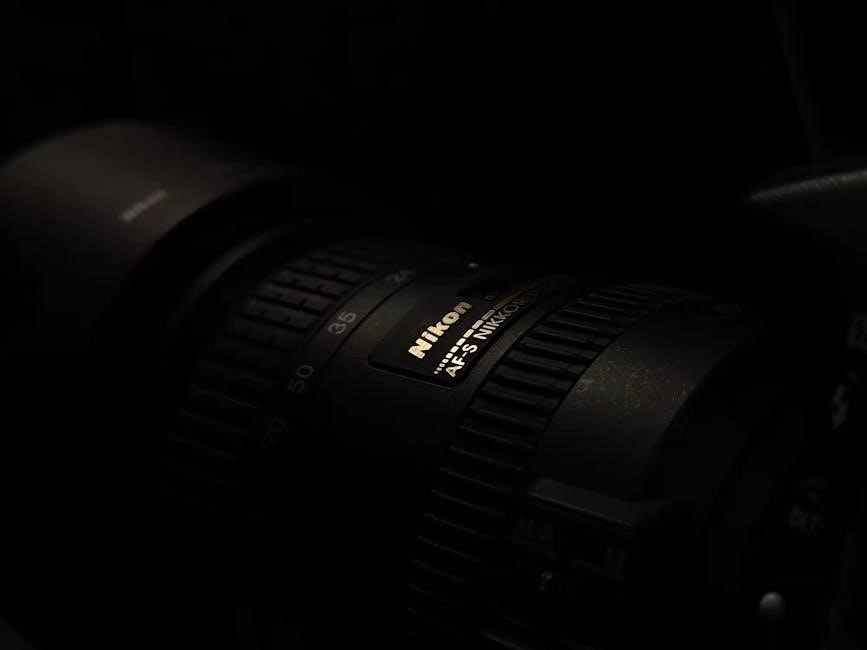
Flash Photography with the Nikon FM
The Nikon FM offers advanced flash photography capabilities, including TTL flash control in Manual and Aperture-Priority modes. This ensures precise and balanced flash exposure.
TTL Flash Control in Manual Mode
The Nikon FM features TTL (Through-The-Lens) flash control, enabling precise light measurement directly through the camera’s lens. In Manual mode, this system ensures accurate flash exposure by automatically adjusting power based on the scene’s brightness. The TTL flash control provides balanced illumination, reducing overexposure and capturing natural-looking results. Additionally, the flash compensation button allows fine-tuning of flash output, making it ideal for challenging lighting conditions like backlit subjects or low-light environments. This feature enhances creativity and control, delivering professional-grade flash photography results.
Flash Compensation Button
The Flash Compensation Button on the Nikon FM allows precise adjustment of flash output, enabling photographers to fine-tune exposure. By pressing this button, users can increase or decrease flash power, ensuring balanced lighting in both bright and low-light conditions. This feature is particularly useful for achieving natural results in challenging environments, such as backlit scenes or high-contrast settings. The flash compensation button provides enhanced control, allowing for more creative and professional flash photography outcomes with the Nikon FM camera.
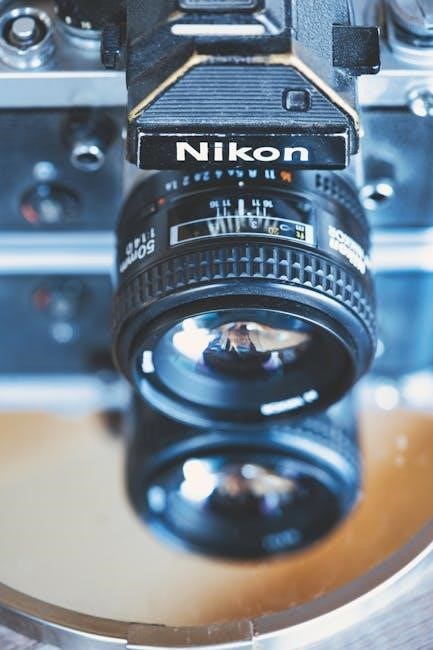
Accessories for the Nikon FM
The Nikon FM supports a variety of accessories, including compatible lenses, flashes, and camera grips, enhancing functionality and personalization for photographers.
Compatible Lenses and Accessories
The Nikon FM is compatible with a wide range of Nikon lenses and accessories, including the iconic Nikkor series. These lenses, from wide-angle to telephoto, ensure versatility in photography. Additionally, the camera supports TTL flash units, enhancing control over lighting conditions. Accessories like camera straps and grips improve handling, while specialized filters add creative effects to images. These tools expand the camera’s capabilities, making it adaptable to various shooting needs and preferences. The compatibility ensures a seamless integration of accessories, maximizing the camera’s potential in different photographic scenarios.
Using the Nikon FM with Modern Accessories
The Nikon FM can be seamlessly integrated with modern accessories, enhancing its functionality. Adapters enable the use of Nikon’s digital lenses, while modern TTL flash units provide precise lighting control. Remote shutter releases and intervalometers offer improved stability and time-lapse capabilities. Additionally, digital tools like mobile apps can aid in tracking exposures and film stocks. These modern accessories breathe new life into the classic Nikon FM, allowing photographers to blend traditional techniques with contemporary convenience. This integration ensures the camera remains relevant and versatile in today’s photographic landscape.
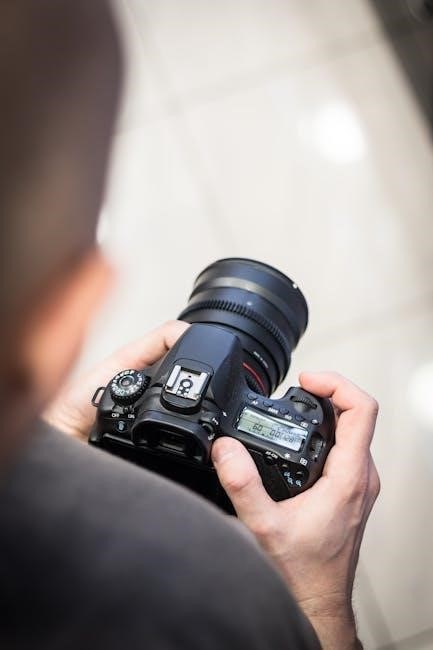
Maintenance and Repair
Regular cleaning of the Nikon FM ensures optimal performance. Use soft cloths for exterior cleaning and avoid harsh chemicals. Lubrication of mechanical parts requires precision. Refer to the repair manual for detailed guidance on servicing and replacing internal components. Proper maintenance extends the camera’s lifespan and ensures reliable operation.
Cleaning the Camera and Accessories
Regular cleaning of the Nikon FM is essential for maintaining its performance. Use a soft, dry cloth to wipe down the exterior and remove any debris. Avoid using harsh chemicals or abrasive materials, as they may damage the camera’s finish. For the lens, use a microfiber cloth and gentle cleaning solutions to prevent scratches. The viewfinder and mirror should also be cleaned carefully to ensure clear visibility. Additionally, inspect and clean the shutter curtains and light meter contacts for optimal functionality. Always refer to the manual for specific cleaning instructions and precautions to avoid damage. Proper maintenance ensures the camera operates smoothly and prolongs its lifespan.
Repair Manual and Service Information
The Nikon FM repair manual is a vital resource for servicing and maintaining your camera. It provides detailed instructions for diagnosing and addressing common issues, such as shutter malfunctions or light meter inaccuracies. The manual includes step-by-step repair procedures, parts replacement guides, and troubleshooting tips. Available as a PDF, it covers the internal mechanisms and offers insights into the camera’s construction. Regularly updated, it ensures compatibility with all FM series models, including the FM2n. Always consult the repair manual before attempting any servicing to avoid further damage. Proper repair ensures the camera’s longevity and optimal performance.
Different Models in the Nikon FM Series
The Nikon FM series includes the FM, FM2, FM2n, FM10, and FM3a. Each model offers unique features while maintaining the core functionality of the FM design.
Nikon FM, FM2, FM2n, FM10, and FM3a
The Nikon FM series comprises several models, each offering unique features. The original FM is a fully mechanical camera, while the FM2 introduced improved shutter speeds. The FM2n added enhanced metering capabilities. The FM10 incorporated automatic film advancement, catering to convenience. The FM3a combined manual and aperture-priority modes, offering versatility. Each model builds on the legacy of the FM, providing photographers with options tailored to their preferences and needs, while maintaining the durability and reliability Nikon is known for.
The Nikon FM models differ in features and functionality. The FM is fully mechanical with a top shutter speed of 1/1000th of a second. The FM2 and FM2n offer higher shutter speeds up to 1/4000th and improved metering systems. The FM3a combines manual and aperture-priority modes, making it versatile. The FM10 includes automatic film winding and simplified controls, appealing to casual users. These distinctions cater to varying photographer needs, from professional to amateur, ensuring each model meets specific demands while maintaining Nikon’s reputation for quality and reliability. Common issues with the Nikon FM include faulty shutter mechanisms, inaccurate light meters, and jammed film advancement. Cleaning contacts and adjusting components often resolve these problems. Common issues with the Nikon FM include faulty shutter mechanisms, inaccurate light meter readings, and film jamming. Cleaning the shutter contacts and adjusting the meter coupling lever often resolve these problems. For persistent issues, consulting the repair manual or seeking professional servicing is recommended. Proper maintenance, such as cleaning the camera and accessories regularly, can prevent many of these common problems. Always refer to the manual for specific troubleshooting steps before attempting repairs. The repair manual is essential for addressing complex issues beyond basic troubleshooting, such as faulty shutter mechanisms or internal component malfunctions. If common solutions fail to resolve problems like inaccurate light meter readings or persistent film jamming, consult the repair manual. It provides detailed instructions for disassembling and repairing the camera, ensuring proper functionality. The revised repair manual is particularly useful due to changes in internal mechanisms, making it a critical resource for advanced diagnostics and repairs. Always refer to it when standard maintenance or troubleshooting steps are insufficient. The Nikon FM manual is a comprehensive guide to maximizing your camera’s potential. Proper maintenance and understanding its features ensure lasting performance and exceptional photography results. To maximize your Nikon FM experience, thoroughly understand its manual controls and features. Experiment with manual exposure modes and aperture-priority for creative control. Regularly clean and maintain the camera to ensure optimal performance. Use compatible lenses and accessories to enhance functionality. Familiarize yourself with film handling techniques for consistent results. Explore resources like repair manuals for troubleshooting and deeper insights. By mastering these aspects, you can unlock the full potential of your Nikon FM and achieve outstanding photography outcomes. To maximize your Nikon FM experience, practice regularly to build familiarity with its manual controls. Experiment with different film stocks and flash photography for creative results. Keep the camera clean and handle it gently to prevent wear. Use a lens hood to reduce glare and a tripod for sharp long exposures. Always refer to the manual for guidance. Explore new techniques to enhance your photography skills. With proper care and dedication, the Nikon FM will deliver exceptional results, making it a reliable companion for both casual and professional photography.Key Differences Between Models
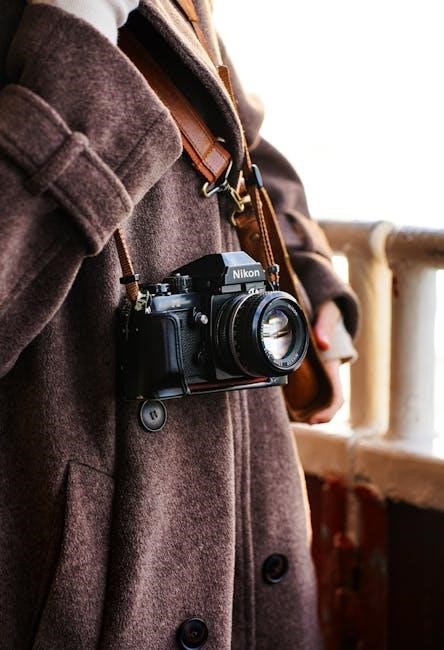
Troubleshooting Common Issues
Common Problems and Solutions
When to Refer to the Repair Manual
Maximizing Your Nikon FM Experience
Final Tips for Getting the Most Out of Your Camera
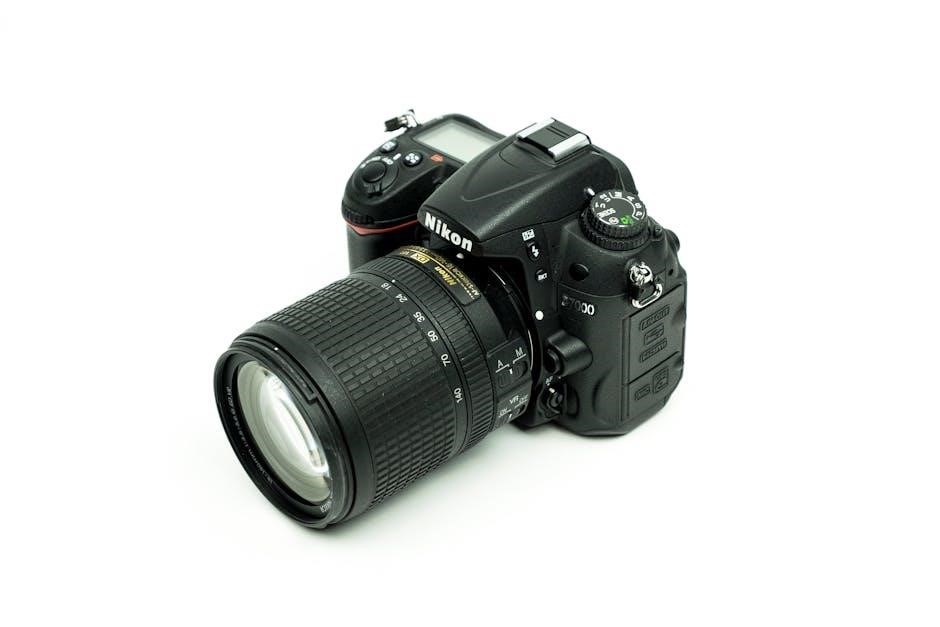



About the author